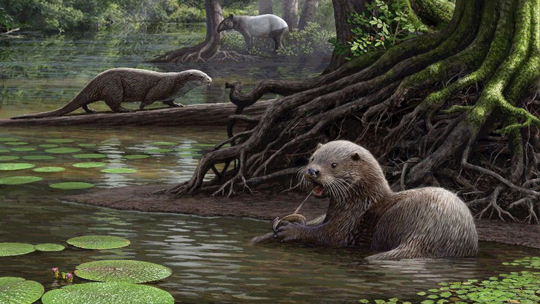Washington, Jan 25: Prehistoric otters may have been of the size of a modern wolf, say scientists who have discovered 6.24 million-year-old fossils of one of the largest otter species known to science. Remains of the large extinct otter, which had large, powerful jaws and is estimated to have weighed about 50 kilogrammes, was found in the northeastern Yunnan Province in China.

The species, named Siamogale melilutra, belongs to an ancient lineage of extinct otters that was previously known only from isolated teeth from a different, much older species that was recovered in Thailand. Researchers from Cleveland Museum of Natural History in the US recovered a complete cranium, mandible, dentition and various skeletal elements - offering a wealth of insight into the taxonomy, evolutionary history and functional morphology of this new species.
"While the cranium is incredibly complete, it was flattened during the fossilisation process," said Denise Su, from the Cleveland Museum of Natural History. "The bones were so delicate that we could not physically restore the cranium. Instead, we CT-scanned the specimen and virtually reconstructed it in a computer," said Su.
The CT restoration showed a combination of otter-like and badger-like features, giving way to the species name "melilutra," which combines the Latin names for badger (meles) and otter (lutra). Siamogale melilutra had a large, powerful jaw with the enlarged, bunodont (rounded-cusped) teeth typical of many otter lineages.
This raises the question of whether these bunodont teeth were inherited by all otters from a common ancestor or evolved independently in different otter lineages over time because of the evolution of similar adaptations to thrive in similar environments - a phenomenon called "convergent evolution."
Through their analysis, researchers found that bunodont teeth independently appeared at least three times over the evolutionary history of otters, suggesting convergent evolution to be the cause. The completeness of the specimens from Shuitangba allows the scientists to better understand the evolutionary history of otters and specifically this enigmatic genus from the Miocene, of which there had been little information.
The findings show that Siamogale belongs to one of the oldest and most primitive lineages of the otter family, which goes back at least 18 million years in the form of Paralutra from Europe. The scientists are working to understand other aspects of the life of Siamogale melilutra.
"The discovery of the otter helps solve some questions about otter relationships, but has opened the door to new questions," said Xiaoming Wang from the Natural History Museum of Los Angeles County in the US. The study was published in The Journal of Systematic Paleontology.





Comments
Add new comment